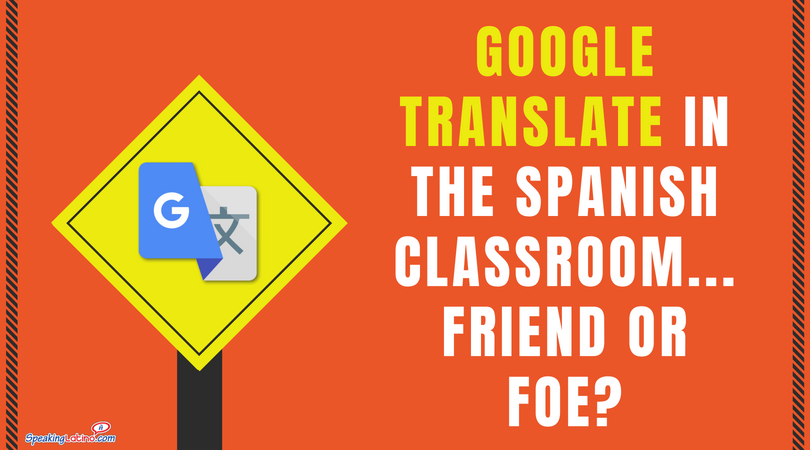
It’s a familiar story…
An average student turns in Spanish homework.
You review the homework thoroughly, hoping that the assignment is complete.
Miraculously, the student’s tendency to write in Spanish without any regard for the dictionary has transformed, overnight, into total grammar perfection.
Perhaps you feel pride swelling for a moment, or perhaps the anxiety hits right away; either way, you quickly become frustrated. Really? Do you really have to confront yet another student about yet another difficult-to-prove cheating incident?
If this situation is familiar to you, know that we feel your pain.
World language teachers across America are struggling with the blessing and the curse that is Google Translate.
This translation tool is uncanny, and its omnipresence is undeniable. Its ability to “learn” and improve with every opportunity to translate a phrase from Spanish to English and vice versa is bizarrely impressive. Better yet (or worse yet, depending on how you feel about the issue), it’s free and widely available to any student who has internet access.
So, we validate your frustration. Even YouTube validates your frustration (check out Malinda Kathleen Reese and her YouTube channel Google Translate Sings; her premise: “What do you think would happen if song lyrics were translated back and forth between multiple languages using only an online translation software?” As one writer on the TVTropes website says, hilarity ensues).
And for better or for worse, Google Translate is improving with every translation; the more the tool translates, the ‘smarter’ it gets; that’s why the Spanish tool is more accurate than the Russian one.
So, what can Spanish teachers do about Google Translate’s pending world domination? Is there anything at all that we can do to interfere with its progress and growth?
Sadly, probably very little, so here’s the real question for you, one that we can actually answer: how do we get ahead of those students who rely on this tool for a passing grade?
Here are a few practical strategies to get you thinking about Google Translate and its role in your classroom.
6 Strategies to Deal with Google Translate in the Spanish Classroom
 1. Do some research to decide where you stand on Google Translate. Then talk with your department head about your position.
1. Do some research to decide where you stand on Google Translate. Then talk with your department head about your position.
How do you feel about Google Translate? Is it the bane of your teaching existence or is it a potentially exciting teaching tool, or something in between?
If a student uses Google Translate on a homework assignment or a writing project, do you view it as a cheating or plagiarism offense, or is it a minor transgression, similar to a student asking a native speaker friend for a little help?
Knowing the answer to these kinds of questions enables you to feel prepared when you face the inevitable. Once you know where you stand, or if you need guidance figuring out where to stand, talk with your department head about your position on this issue.
If you are sure you have the support of your higher-ups, those difficult conversations with a student and/or parent will go a lot more smoothly.
 2. Start talking with your students openly about Google Translate.
2. Start talking with your students openly about Google Translate.
Let your students know that you’re aware. Once they know that you know that Google Translate exists and that they know how to use it, the tool loses some of its power.
By initiating the conversation, yourself, you are showing your students that Google Translate is comfortably within your teacherly jurisdiction. This is the Google Translate equivalent of settling into your classroom at least five minutes before your students arrive so you can establish that the classroom is your territory.
Google Translate can be your territory too, so talk about it with confidence, and your students will realize that you’re not simply reacting to a situation that is beyond your control.
 3. Invest time in teaching your students how to use a Spanish/English dictionary.
3. Invest time in teaching your students how to use a Spanish/English dictionary.
Though Spanish/English dictionaries are on most book lists for most Spanish classes, a lot of students don’t actually know how to use one. And if students find their paper dictionaries a challenging hassle to use, where will they turn for easy and speedy answers? Google Translate.
Make a point of rewarding dictionary use once your students can work with their dictionaries with confidence. Encouraging Luddite behaviors in your students can become a classroom bonding experience, so don’t hold back.
Bring in an old-school phone to place on your desk as a symbol of your celebration of all things analog and turn your students’ groans into a humorous opportunity to showcase how why the dictionary is a valuable tool for Spanish scholars of all levels.
 4. Acknowledge the strengths and the shortcomings of Google Translate with true to life examples.
4. Acknowledge the strengths and the shortcomings of Google Translate with true to life examples.
Discuss with students the pros as well as the cons of Google Translate. Google Translate is remarkably reliable when used as a dictionary, but it relies on the correct spelling of the original word.
Imagine what might happen if you misspell “petal” as “pedal” and “flower” as “flour” when searching for the Spanish equivalents; if you don’t notice you’ve made a mistake, you might confuse your reader who is wondering what you mean by pedales de harina (“flour pedals”).
As well, Google Translate struggles with idioms; unless a Spanish idiom has been entered into the tool many times, the algorithms assume that a literal translation is the correct translation.
Check out the lesson plan Google Translate: Friend or Foe? included inside our freebies section. To access all our freebies, create your free account here.
 5. Assign writing assignments and writing assessments in class.
5. Assign writing assignments and writing assessments in class.
This suggestion might be a painful one for some teachers who already feel their time in the classroom is limited. It can feel frustratingly wasteful to devote valuable face time with students to mere supervision and cheating prevention.
Try experimenting with short but frequent writing tasks to develop writing habits in your students; start class with a five-minute free writing about a vocabulary word you put on the board. If this approach works, consider adding an in-class journal to your list of assessments; daily writing in Spanish will do wonders for your students’ confidence and you only have to glance at their journals weekly to make sure they’re on track or to learn what grammar concepts might need a little more airtime.
 6. If you can’t beat ‘em, join ‘em.
6. If you can’t beat ‘em, join ‘em.
Some teachers are passionate about their rejection of Google Translate, and we respect their position. However, there is some merit to embracing Google Translate and incorporating the tool into your lesson plans.
Ask beginning students to write a five-sentence paragraph in English, enter them into Google Translate for the Spanish version, and then instruct them to improve the translation in three different ways or to identify three new points of Spanish grammar or vocabulary they learned from the translation. Discuss the points in class to make sure everyone is on the same page, and if Google Translate gets something wrong and you catch the mistake, you validate its unreliability right in front of your students.
The lesson plan Google Translate: Friend or Foe? (Available inside our freebies section.) offers you more teaching ideas that attempt to make the most of what Google Translate can offer the classroom.
So, there you have it. Like many other miracles of the tech world, Google Translate certainly can make life easier for some and harder for others.
